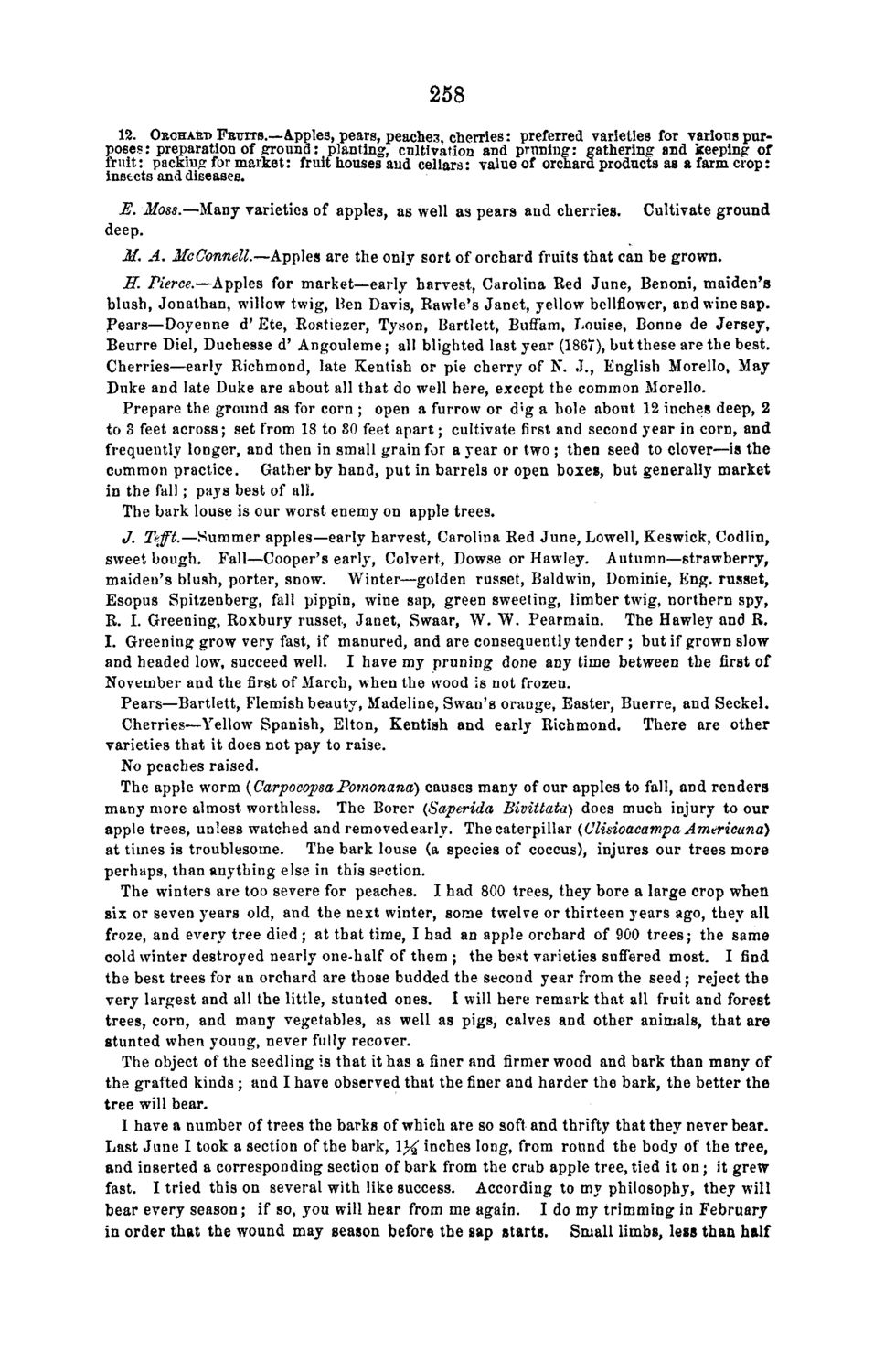| |
| |
Caption: Board of Trustees Minutes - 1868
This is a reduced-resolution page image for fast online browsing.

EXTRACTED TEXT FROM PAGE:
258 12. OEOHAED FauiTs.—Apples, pears, peache3, cherries: preferred varieties for various purposes: preparation of ground: planting, cultivation and pruning: gathering and keeping of fruit: packing for market: fruit houses aud cellars: value of orchard products as a farm crop: insects and diseases. E. Moss.—Many varieties of apples, as well as pears and cherries. deep. M. A. McConnell.—Apples Cultivate ground are the only sort of orchard fruits that can be grown. JET. Pierce.—Apples for market—early harvest, Carolina Red June, Benoni, maiden's blush, Jonathan, willow twig, Ben Davis, Rawle's Janet, yellow bellflower, and wine sap. Pears—Doyenne d ' E t e , Rostiezer, Tyson, Bartlett, Buff am, Louise, Bonne de Jersey, Beurre Diel, Duchesse d' Angouleme; all blighted last year (1867), but these are the best. Cherries—early Richmond, late Kentish or pie cherry of N. J., English Morello, May Duke and late Duke are about all that do well here, except the common Morello. Prepare the ground as for corn ; open a furrow or d'g a hole about 12 inches deep, 2 to S feet across; set from 18 to 80 feet a p a r t ; cultivate first and second year in corn, and frequently longer, and then in small grain for a year or two ; then seed to clover—is the common practice. Gather by hand, put in barrels or open boxes, but generally market in the fall ; pays best of all. The bark louse is our worst enemy on apple trees. J. Tefft.—Summer apples—early harvest, Carolina Red June, Lowell, Keswick, Codlin, sweet bough. Fall—Cooper's early, Colvert, Dowse or Hawley. Autumn—strawberry, maiden's blush, porter, snow. Winter—golden russet, Baldwin, Dominie, Eng. russet, Esopus Spitzenberg, fall pippin, wine sap, green sweeting, limber twig, northern spy, R. I. Greening, Roxbury russet, Janet, Swaar, W. W. Pearmain. The Hawley and R. I. Greening grow very fast, if manured, and are consequently tender ; but if grown slow and headed low, succeed well. I have my pruning done any time between the first of November and the first of March, when the wood is not frozen. Pears—Bartlett, Flemish beauty, Madeline, Swan's orange, Easter, Buerre, and Seckel. Cherries—Yellow Spanish, Elton, Kentish and early Richmond. There are other varieties that it does not pay to raise. No peaches raised. The apple worm (Carpocopsa Pomonana) causes many of our apples to fall, and renders many more almost worthless. The Borer (Saperida Bivittata) does much injury to our apple trees, unless watched and removed early. The caterpillar (Clisioacampa Americana) at times is troublesome. The bark louse (a species of coccus), injures our trees more perhaps, than anything else in this section. The winters are too severe for peaches. I had 800 trees, they bore a large crop when six or seven years old, and the next winter, some twelve or thirteen years ago, they all froze, and every tree d i e d ; at that time, I had an apple orchard of 900 t r e e s ; the same cold winter destroyed nearly one-half of them ; the best varieties suffered most. I find the best trees for an orchard are those budded the second year from the seed; reject the very largest and all the little, stunted ones. I will here remark that all fruit and forest trees, corn, and many vegetables, as well as pigs, calves and other animals, that are stunted when young, never fully recover. The object of the seedling is that it has a finer and firmer wood and bark than many of the grafted k i n d s ; and I have observed that the finer and harder the bark, the better the tree will bear. 1 have a number of trees the barks of which are so soft and thrifty that they never bear. Last J u n e I took a section of the bark, X% inches long, from round the body of the tree, and inserted a corresponding section of bark from the crab apple tree, tied it o n ; it grew fast. I tried this on several with like success. According to my philosophy, they will bear every season; if so, you will hear from me again. I do my trimming in February in order that the wound may season before the sap starts. Small limbs, less than half
| |